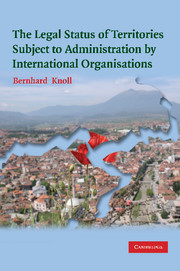Book contents
- Frontmatter
- Contents
- Illustrations
- Foreword: Pierre-Marie Dupuy
- Acknowledgements
- Table of Cases and Judicial Decisions
- List of Abbreviations
- Introduction
- 1 Creation of internationalised territories
- 2 Fiduciary administration: mandates, trust and the transitory sovereignty vacuum
- 3 Self-determination and the personality of internationalised territories
- 4 ‘The King's two bodies’: the dual functions of international administrations
- 5 Extent of UN authority in Kosovo and the problem of an open-ended institution-building mandate
- 6 The status process: Kosovo's endgame
- 7 An anomalous legitimacy cycle
- 8 Properties of a transitory legal order
- Concluding appraisal
- Bibliography
- Index
1 - Creation of internationalised territories
Published online by Cambridge University Press: 11 August 2009
- Frontmatter
- Contents
- Illustrations
- Foreword: Pierre-Marie Dupuy
- Acknowledgements
- Table of Cases and Judicial Decisions
- List of Abbreviations
- Introduction
- 1 Creation of internationalised territories
- 2 Fiduciary administration: mandates, trust and the transitory sovereignty vacuum
- 3 Self-determination and the personality of internationalised territories
- 4 ‘The King's two bodies’: the dual functions of international administrations
- 5 Extent of UN authority in Kosovo and the problem of an open-ended institution-building mandate
- 6 The status process: Kosovo's endgame
- 7 An anomalous legitimacy cycle
- 8 Properties of a transitory legal order
- Concluding appraisal
- Bibliography
- Index
Summary
Referring to processes and methods of transferring effective control over territory, this first chapter concentrates on territories under international administration as experimental models of ‘restricted sovereignty’. One of its major thrusts consists in arguing that the demands of political reality have forced sovereign states for centuries to consent to agreements by which they relinquished a portion of their sovereignty – of the suprema potestas – in favour of another sovereign entity. Likewise, as James Crawford pointed out, the establishment of autonomous entities under a form of international protection, supervision, or guarantees has been a ‘persistent form of organisation of territories disputed between States on strategic or ethnic or other grounds’. We shall pursue these two arguments by interrogating an analogy, drawn by Grotius, Pufendorf and Selden, between the Roman private law concept of dominium and sovereignty over territory. While the analogy allows us to grasp the key conception of the institution of ‘legal sovereignty’, it also permits us to examine the various practices which were instrumental in devising exceptions to the application of dominium over territory. We will hence begin by adopting an in rem perspective in order to capture international legal solutions that were applied to situations in which title to territory had been divorced from imperium, or what German constitutional doctrine refers to as Gebietshoheit.
- Type
- Chapter
- Information
- The Legal Status of Territories Subject to Administration by International Organisations , pp. 18 - 52Publisher: Cambridge University PressPrint publication year: 2008



